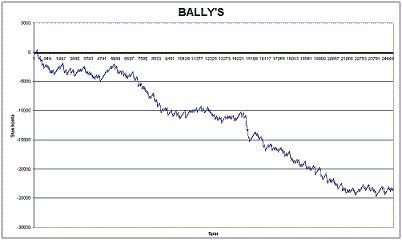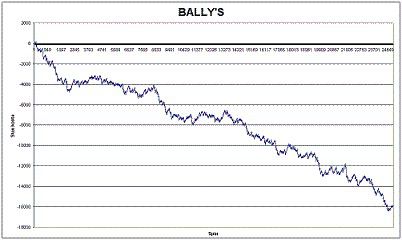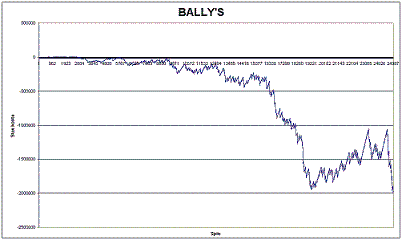This system is called the Bally’s. It works by putting units on the table in a certain way and if you lose, you use a progression. The principles of the game are:
- 2 units on the line 1 – 0 (which associates 0 with the numbers 1, 2 and 3)
- 1 unit on the split 4 – 5 (where they meet the numbers 4 and 5)
- 3 units on the six-line from 10 – 15
- 2 units on the corner of 20 – 24 (where they meet the numbers 20, 21, 23, 24)
- 1 unit on the split 22 - 25 (where they meet the numbers 22 and 25)
- 1 unit on the split 30 – 33 (where they meet the numbers 30 and 33)
- 2 units on the corner of 31 – 35 (where they meet the numbers 31, 32, 34 and 35)
There are 12 units altogether on the first spin. If you hit, a profit of 6 units is won. If you lose, you multiply all your bet sizes by 3. So altogether you bet 36 units in the second spin, 108 units in the third spin and 324 units in forth spin. If you lose 4 times in a row, you start again from the beginning.
What do the Statistics say?
Having a bet on 24 out of the 37 total numbers, the probability of winning on each spin is 64, 86%. The probability that you will not hit 4 times in a row is 1, 52%. It practically means that you win 98, which is 5 times the profit of 6 units in 100 spins (591 units in total) and you lose 1, 5 times a loss of 480 units (720 units in total). Obviously, you do not make a profit...
We have attempted to design a progression. The results of the progression are shown in the following graph:

Unfortunately, this did not turn out to be as successful as proposed. The betting system went continuously below zero and it had a loss of 25.000 units per 25.000 spins. The system was unusable in this form.
We tried to apply some modifications such as altering the number of spins in a series. What would be the effect of reducing the number of spins to 3, or increasing the number of spins to 6 or 12? The results of these modifications are shown in the following graphs:



No spectacular results were observed. When the number of spins was reduced (as shown on the first graph) the progression did not change in terms of type, the regression below zero just occurred more slowly. When the number of spins was increased to 6 (as shown on the third graph) the whole graph was more “serrated”, but the progression still remained the same. It was only when the number of spins was vigorously increased to 12 (as shown on the second graph) that we observed an upward trend, unfortunately, the “hairs” hanging from the curve are representative of the Martingale progression.
The curve steadily increased resulting in a profit, but sometimes drastically plunged (local slumps) and a huge amount of money was required to cover these losses (the slumps even reached values of 300.000 units). In reality, it is not possible to wager such large sums of money (even if we had access to large funds) due to certain table limitations etc. Therefore this method is not feasible.
We also attempted to apply a progression. We returned to our original plan by applying the 4 spin limitation. After each losing series, we increased the size of the bet by 1 unit. What was the outcome?

Again, no spectacular results were observed. The system oscillated around zero much longer, but finally, the downward trend achieved dominance and fell well below zero (a single loss reached values of up to 1.000.000 units), so this was very dangerous…..
This system also appears to be unusable in long-term betting.
Moreover, we have prepared a roulette betting simulator, where you can try this system for free.

 EN
EN  čeština
čeština  Polski
Polski  Slovenčina
Slovenčina  Русский
Русский  Deutsch
Deutsch  Slovenski
Slovenski  Dutch
Dutch  Svenska
Svenska  Português
Português  Italiano
Italiano  Español
Español  Français
Français  Suomalainen
Suomalainen  Български
Български  Românesc
Românesc  Magyar
Magyar  Eesti
Eesti  Ελληνική
Ελληνική  Latviešu
Latviešu  Lietuvių
Lietuvių  やまと
やまと  中国
中国  Dansk
Dansk  Türkçe
Türkçe  ID
ID  Українська
Українська  한국어
한국어  Norsk
Norsk  Peter Sommer
Peter Sommer 






You have to be logged in to add a comment